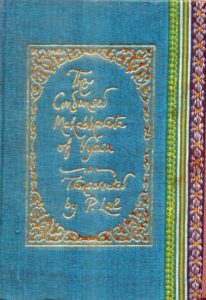 The Condensed Mahabharata of Vyasa by P. Lal, First published 1980, 3rd edn 2010 (Revised and Corrected) Price: HB Rs 600, FB Rs 400
The Condensed Mahabharata of Vyasa by P. Lal, First published 1980, 3rd edn 2010 (Revised and Corrected) Price: HB Rs 600, FB Rs 400
We have in hand a gorgeously produced reprint of the 1980 Vikas edition of Padma Shri Dr. P.Lal’s condensed transcreation of Vyasa’s epic. R.C. Dutt, the first ‘condenser’ of the Mahabharata’s one lakh shlokas, chose to spare the Western reader the “unending morass’ and “monstrous chaos” of episodical matter by leaving out whatever he felt to be super-incumbent.
The result was a Tennysonian Vyasa rhythmically relating in Locksley-Hall metre his knightly tale of barons at war in two thousand English couplets.
In the process Dutt sacrificed much that is integral to the Vyasan ethos: most of the Book of Beginnings and the Book of the Forest, and all of the Club, the Great Departure and the Ascent to Heaven books.
Here Prof. Lal has condensed the hard-core narrative of the Pandava-Dhartarashtran conflict, around which a vast collection of myths, legends, folklore, philosophy and homilies was woven to make up the great epic of Bharata. A complementary project, Mahabharata Katha, is underway, the first of which, The Ramayana in the Mahabharata, is out. Successive volumes will make available to the English-speaking world those peripheral episodes which are, nevertheless, integral parts of the Vyasan universe articulating leitmotifs that run as unifying themes linking the apparently chaotic medley of episodes.
To the modern reader who has neither the time, nor perhaps the inclination, to seek out the iridescent Ariadne’s thread to follow through the epic labyrinth, the Lalian approach is richly rewarding. Besides a valuable 67 page introduction, a family tree, a map showing India at the time of the Mahabharata, an annotated bibliography and an index to proper names, his condensation differs markedly from those of Dutt, Rajagopalachari, R.K. Narayan, Kamala Subramanyam, Meera Uberoi and Ramesh Menon in that he neither re-tells nor adds. Dr. Lal is the only condenser who also transcreates, giving the story ‘always in Vyasa’s own words, without simplifying, interpreting, or elaborating’ preferred Vyasan dialogue to straight narration and report.’
It is not his intention to narrate merely the essential story of the fratricidal war but also to communicate the ‘feel’ of the epic; that ineffable flavour which transforms a sordid account of a bloody clan-war into the Mahabharata. With this end in view, he incorporates a number of incidents which do not appear, at first glance, to have any link with the central story, e.g. the Arjunaka-serpent-Gautami episode in the 13th Book, the memorable parable of the Drop of Honey related by Vidura to Dhritarashtra in Book 11, and the repeated exhortation regarding ahimsa in this violent epic – so violent that, traditionally, it is prohibited reading for nubile women.
It is to correct the general impression that the Mahabharata is off limits to women that Kavita Sharma, principal of Hindu College, Delhi, has written her study of the royal epic women, pairing Satyavati and Amba (though the parallels are far more between the former and her grand daughter-in-law Kunti and between the latter and her daughter-in-law Draupadi), Gandhari and Kunti, Draupadi by herself and Arjuna’s wives whom she groups as ‘warrior queens’. In the last group her coverage of Alli, Pavazhakkodi, Minnoliyal and Pulandaran from the Tamil ballads is extremely valuable. One wishes that she had included the insights provided by Bhasa and Bhatta Narayana.
There are some glaring errors such as ‘Rishi Gavala’ instead of ‘Galava’ (p.4) and Vibhruvahana instead of ‘Babhruvahana’ (p.113). While discussing Draupadi, she fails to note (despite listing Hiltebeitel’s research on Rajasthani ballads in the bibliography) how the popular imagination reincarnated her in medieval times as Bela in the Alha. Puzzled by Draupadi’s silence when married off to five husbands, she proffers haphazard explanations, completely missing out that her appearance Kritya-like during a sacrifice is followed by a declaration that she will be the agent of the gods for the destruction of the warrior clans and she is called a puppet, ‘Panchali’ (her behaviour often suits that appellative). Her marriage to Yudhishthira, son of Yama-Dharma is ominously appropriate. She is the mysterious femme fatale who inveigles five Indras into being sentenced by Shiva to be reborn as the Pandavas with her as their wife to ensure that the intended holocaust occurs. The course of the epic is determined by the dark four and Kunti: Kali-Satyavati, Krishna Dvaipayana Vyasa, Vasudeva Krishna, Draupadi-Krishnaa, and Kunti. While Yamuna’s black waters link the first three, Satyavati, Kunti and Draupadi are prototypes of one another.
Superficial study of the epic is indicated when Sharma recounts Krishna saving Draupadi from being stripped where Vyasa refers to Dharma (another name for Vidura) having clothed her, the passage regarding Krishna being an interpolation consigned to an appendix in the Critical Edition.
While summarising Draupadi’s advice to Satyabhama, Sharma diligently lists all the chores of the dutiful wife, failing to note two interesting points: the complete account of income and expenditure of her husbands was in her grasp and she alone knew the extent of their wealth; she kept track of what each of the many maids attending on Yudhishthira was doing; and she took particular care never to surpass her mother-in-law in ornaments, dress and even the food taken, besides avoiding all criticism of Kunti (III.233. 38, 41).
Surprisingly, Sharma does not notice how skillfully Draupadi uses her charms to get her way time and again, particularly with Bhima and Krishna.
While her book is a sorely needed corrective and provides a popular overview of the role women play in the epic, it would have benefited considerably by reference to Sr. M.A. Hughes’ study, Epic Women: East and West (Journal of the Asiatic Society), Saoli Mitra’s Nathavati Anathavat and Katha Amrita Saman, Chitra Chaturvedi’s Mahabharat, Tanaya and Amba nahin mein Bhishmaa, the 2003 national conference on Pancha Kanya – the five virgins of India’s Epics and the 2005 MANUSHI-ICCR international panel on it in New Delhi. The bibliography contains references that have nothing to do with the subject (E.A.Johnson, Sheetan) and though dated 2006, is innocent of the most important work on the epic, Hiltebeitel’s 2001 ‘Rethinking the Mahabharata’.
The Lal condensation is distinguished by the inimitable choice of passages from the original which no other abridgement has incorporated. Thus, in the beginning of Book 12 is Yudhishthira’s lament over Karna’s death:
‘Even when Karna spoke harshly to us in the palace assembly room, my anger cooled when my eyes fell by chance on his feet. They were our mother Kunti’s feet’ And he goes on to utter words that sum up the existential angst at the root of the epic: ‘We have squabbled like a pack of dogs over a piece of meat, and we have won – and the meat has lost its savour. The meat is thrown aside, the dogs have forgotten it.’
This is precisely what the epic is about – or, at least, one of the many things it is about. This theme of a pyrrhic victory, in which the victors ‘instead of gust chew bitter ashes,’ is stressed again and again in passages omitted in other condensations: ‘Enjoy the barren world – it is now yours’, says Duryodhana at bay, bear-like at the stake surrounded by snarling, slavering Pandavas. ‘You have a world to yourself, a world without friends, horses, chariots, elephants, forts. Enjoy her.’
Yudhishthira shouts, ‘You rave like a madman’ – a desperate attempt to drown the grinning skull and the rattle of bones in lung-power. But truth will out, and it comes at the very end in Yudhishthira’s apocalyptic vision of his kinsmen in hell while his enemies loll on celestial couches.
This is the climactic episode of the theme stated un-compromisingly just before the holocaust begins when Arjuna states blandly that the war is being fought neither for avenging Draupadi, nor for ‘dharma’, but for an extremely mundane and selfish objective: land.
If, then, the epic is such a sordid affair, what lends it memorability and relevance today? It is those situations where characters are shorn of all their trappings and face the ultimate test, forced to play chess with death. Such is the dramatic moment when time stands still as Yudhishthira answers the Yaksha of the lake over the corpses of his brothers. Such is the incident where Yudhishthira, again, replies to his ancestor Nahusha crushing the invincible Bhima in his adamantine coils. Such, yet again, is that tremendous scene where Yudhishthira faces Indra and refuses to give up his canine companion for heaven.
Then there are those other intensely human episodes true for all time: the confrontation between Kunti begging Karna to join her other sons; Draupadi putting the entire peerage to shame with an unanswerable question; Draupadi’s upalambha to Bhima after Kichaka has kicked her; Arjuna facing his brothers finding Abhimanyu slain; Amba, rejected by Salva, facing Bhishma. It is woman and man in all their passionate intensity – all the blood, toil and tears that makes up this short and brutish life. And yet it is man who questions the Divine, wrestling with him, as Arjuna with Shiva physically, or intellectually as Arjuna with Krishna, till God has replies to logic with magic to stun him into submission, as Jehovah to Job out of the whirlwind. It is all this which lends this sometime-ballad of the Bharata clan its epic dimensions and eternal appeal.
The selection of incidents from the original for inclusion in this condensation is itself a feature which distinguishes it from other condensations. The choice is carefully guided by Dr. Lal’s overview of recurring themes or patterns. Take, for instance, the Gita itself, which is missing from most of the other abridgements. Lal carefully incorporates a dialogue between Draupadi and Yudhishthira in the forest which looks forward to the philosophy of nishkama karma and of following one’s dharma.
This is a passage providing rare insights into the respective speakers which readers of other condensations have missed.
The episode of the sage Brihadashva’s visit to the exiled princes appears unnecessary but on closer examination the links with the plot become clear. This sage imparts to Yudhishthira mastery in casting the dice, which is of crucial importance for maintaining his disguise in Virata’s court. It is also skillfully placed immediately after Urvashi cursing Arjuna with eunuch-hood, another boon for the period of ‘exile-in-disguise’. A valuable inclusion is Karna’s retelling of a dream to Krishna which all other condensers miss, completely in consonance with Prof. Lal’s awareness of the underlying theme of pyrrhic victory: ‘I saw you (Krishna) in that dream, busy scattering weapons of war on the blood-red earth. Then I saw Yudhishthira standing on a heap of bones, gladly licking thick sweet curd from a golden plate’.
A remarkable quality of the Lal condensation is the effortless shifting from prose to verse according to the demands of the original. The use of verse in describing Hidimba’s honeymoon, the Pandavas’ stay in the Dvaita forest, Bhima’s obtaining the golden lotus and the description of the rains, help to create and communicate the other-worldly and idyllic flavour of the original. On another unforgettable occasion Lal changes with a sure touch from prose to verse to describe Urvashi approaching Arjuna as abhisarika whose delicate nuances can hardly be communicated in prose. Vyasa also uses verse for rendering solemn ritualistic passages such as Sanjaya consoling the blind monarch, the women wailing over the corpse-strewn field, Gandhari upbraiding Krishna, and the tremendous calling-up of ghosts of the departed from the waters of the Bhagirathi in a translation redolent of the Odyssey.
Prof. Lal’s faithfulness to the original affords valuable insights into characters which other condensations miss. In the svayamvara of Draupadi, her joy at the Brahmin-Arjuna’s success vis-‘-vis her disgust at the Suta-Karna’s entering the contest reveals certain caste-snobbery. Lal carefully brings out Yudhishthira’s cussed mule-headedness in his sparing the rapist Jayadratha and in offering to surrender the kingdom if any of the Pandavas are worsted by Duryodhana in a duel. Krishna’s furious berating of such woolly-thinking is often missing in condensations: ‘It was foolish of you to gamble away our advantage now, just as you gambled everything away to Shakuni.’ Most interesting is Krishna’s inability to recreate the Gita experience when requested by Arjuna before he leaves for Dvaraka after the war: ‘I could not now recall what I said then, even if I wished. How will I get all the details right?’
There is the bland statement of Bhishma and Drona, omitted in other abridgements, explaining why they fight for Duryodhana: ‘A man is the slave of wealth though wealth is no one’s slave. The wealth of the Kauravas binds me to them.’ Then there is that solitary glimpse into Draupadi’s heart as she wails to Bhima in Virata’s court: ‘Any woman married to Yudhishthira would be afflicted with many griefs….What does Yudhishthira do? He plays dice…Look at Arjuna… A hero with earrings!
…You saved me from Jayadratha … and from Jatasura … I shall take poison and die in your arms Bhima.’
This is the source of Iravati Karve’s brilliant exposition of Draupadi’s thoughts as she lies dying and murmurs to Bhima, ‘Aryaputra, in the next birth, be born the eldest!’
It is the inclusion of such incidents and rendering them with careful exactitude which make the Lal version uniquely valuable. In addition there is the sheer readability of the transcreation.
There are, however, a number of omissions that detract from the plot interest. We are not told why the Vasus were cursed to be born as Shantanu’s sons, nor how the fish-odorous Satyavati acquires the lotus-scent which draws the king to her. There is a contradiction between pages 102 and 106 between who was born first and who was conceived first – Yudhishthira or Duryodhana. The Ekalavya episode does not mention how this rejected pupil used to practise archery before a statue of Drona. Drona’s birth is omitted though it provides insight into why he is virtually caste-less and spurned by Drupada. Page 120 conveys a mistranslation: the Pandavas do not flee to Varanavata on Vidura’s advice; they go there on Dhritarashtra’s insistence and flee from there with Vidura’s help. The killing of Baka is omitted with its remorseless scrutiny of family relationships and Kunti’s remarkable decisions as a leader. An unfortunate omission is Krishna’s Machiavellian strategy in deliberately throwing Ghatotkacha as bait to attract Karna’s infallible weapon. The atrocious killing of Bhurishravas by Arjuna and Satyaki, referred to on page 409, is another uncalled for omission.
The most critical lapse occurs on page 393 where at the end of Yudhishthira’s horse-sacrifice Prof. Lal unaccountably omits the story that the half-golden mongoose relates, making the ending of Book 14 trite and inexplicable. There is a cryptic reference on page 101 to Gandhari having once sheltered Vyasa when he was dying from hunger which is neither expanded nor found in the original. The story of Shikhandin-Amba’s birth is left out though it is one of the threads that link the Adi to the Bhishma Parva: Amba is the hamartia in Bhishma’s tragedy. The Arjuna-Shiva encounter is yet another memorable incident which has been omitted.
What is the final impression with which this condensation-cum-transcreation leaves us? It is the anguished cry of a man who has witnessed his progeny slaughter one another in insane strife:
I raise my arms and I shout- but no one listens!
From dharma come wealth and pleasure:
Why is dharma not practised?
This is the story of Vyasa and his descendants, all corrupted by that single consuming weakness – lust. With unerring instinct Lal has incorporated in his condensation a speech by Pandu which touches the core of this tragic flaw – a speech which most condensers drop – ‘Addiction to lust killed my mother’s husband, though the virtuous Shantanu gave him birth. And though truth-speaking Vyasa is my father, lust consumes me too’. The seed of lust runs through both sides of the family. It consumes Shantanu who marries a fisherwoman in his dotage, depriving his kingdom of its rightful and able heir, Devavrata. Mahabhisha is reborn as Shantanu for having looked lustfully on Ganga in Brahma’s court when the wind uplifted her dress. Vichitravirya, child of his old age, carries the same weakness and dies of sexual over-indulgence. Satyavati is a product of Uparichara’s lust. Vyasa is born of Parashara forcing himself on Satyavati mid-stream in a boat. Satyavati refuses to put her daughters-in-law through the year-long purificatory penance which Vyasa advises. They await their brother-in-law Bhishma lust-fully and, shocked at the advent of Vyasa, the union inevitably produces flawed progeny. The curse, like the Erinyes, pursues the entire family. It is the supreme irony of the epic that ultimately the Puru lineage and the dynasty Satyavati sought to found through Vyasa are extinct. No wonder Vyasa finally cries out in despair at man’s deliberate rejection of salvation and the remorseless working out of the tragic flaw ingrained deep within, driving him to destruction.
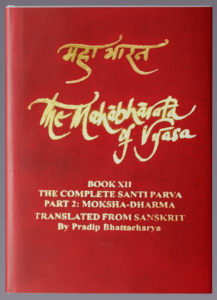
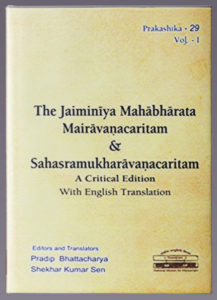
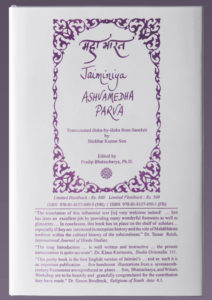
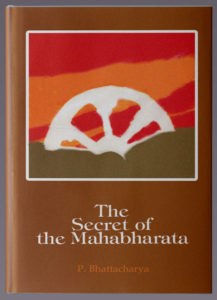
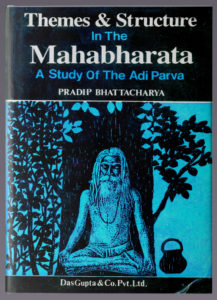
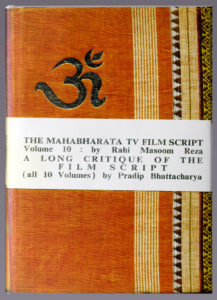
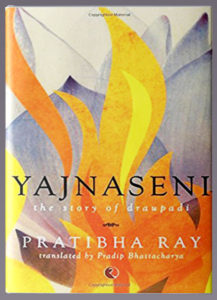
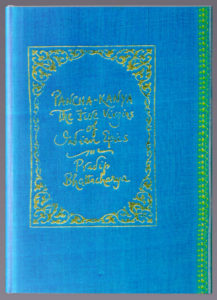
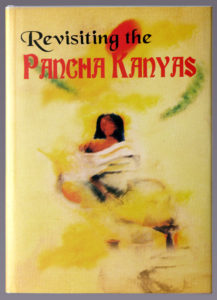
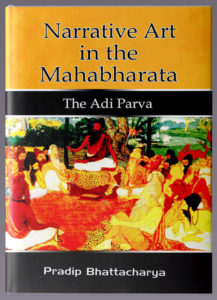
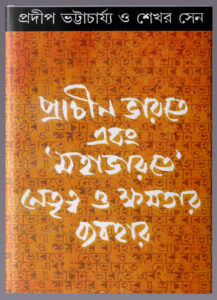
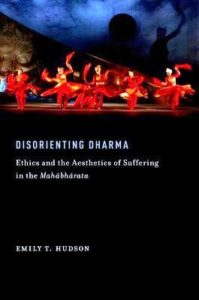
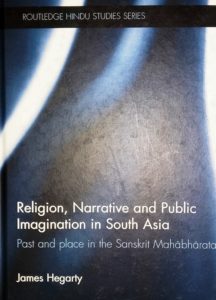 234 pages.
234 pages.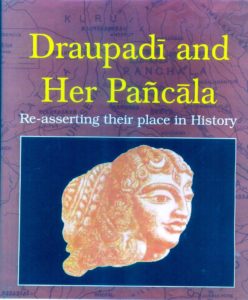
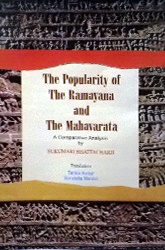 Sukumari Bhattacharji: The Popularity of the Ramayana and the Mahabharata—A Comparative Analysis. Translated by Tanika Sarkar and Somdatta Mandal. Anustup, 2018, pp. 109, Rs.300/-
Sukumari Bhattacharji: The Popularity of the Ramayana and the Mahabharata—A Comparative Analysis. Translated by Tanika Sarkar and Somdatta Mandal. Anustup, 2018, pp. 109, Rs.300/-